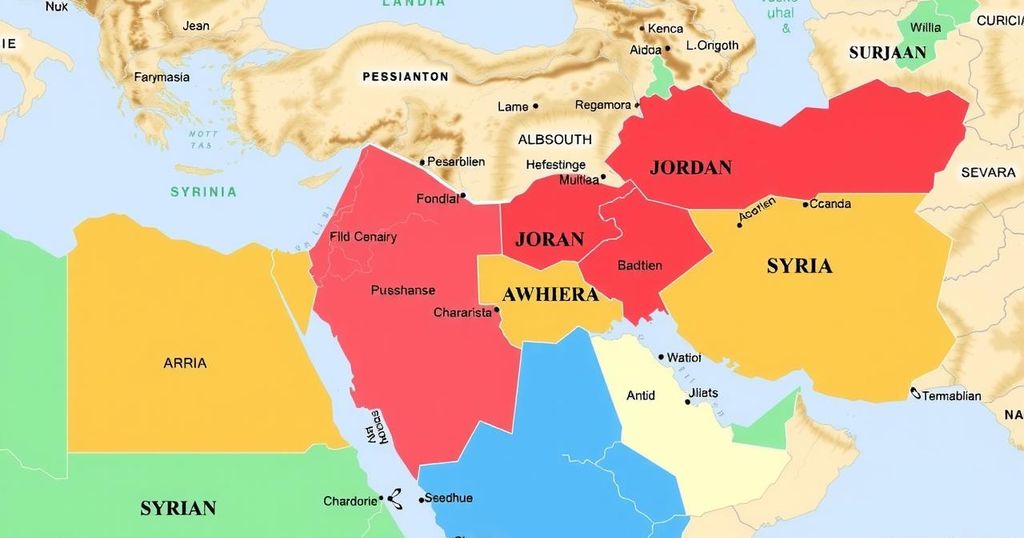Voluntary Land Swaps: A Path to Stability in the Middle East

Voluntary land swaps in the Middle East may foster regional stability, particularly for Jordan and Israel, by realigning borders to enhance security. Current geopolitical threats, historical context, and economic potential strengthen the case for such swaps, with leadership from President Trump seen as a catalyst for change.
In the complex landscape of the Middle East, there are growing discussions surrounding voluntary land swaps aimed at stabilizing the region. With the lingering impacts of historical borders, particularly those established under foreign powers, current geopolitical alignments could pave the way for beneficial realignments. Notable shifts are arising due to the recent turmoil in Syria, the diplomatic maneuvers of U.S. President Donald Trump, and looming threats from Iran and Sunni extremism in the region.
The case for Jordan’s involvement in such swaps highlights a need for redefining its indefensible borders. Jordan, carved from the 1920 disintegration of the Arab Kingdom of Syria, is flanked by enemies, making it vulnerable today. Historically, Jordan’s conflicts stemmed from Israel; however, the tables have turned as threats are now emanating from the east and north. The current Jordanian king faces challenges not only from Iran and the rise of extremist groups but also the instability in Syria directly abutting its territory.
This alarming evolution has compelled Jordan to reconsider its geographical definitions. To fortify its defenses, Jordan might find advantage in acquiring land in southern Syria while reluctantly parting with parts of its western territories, sometimes considered militarily insignificant. This repositioning could yield not only safety but also stimulate economic growth, perhaps rekindling Jordan’s role as a leader in the Arab world. The historical ties to the southern region, where the Hashemite dynasty originally held sway, could further strengthen national identity.
The urgency of Israel’s own borders cannot be understated. The recent collapse of the Syrian regime on October 7 has reconfirmed that the Jordan River lacks adequate defensibility for the nation. If a poorly organized group could exploit the Gaza border, one can only imagine a well-equipped military force penetrating through Jordan. Israel must now reconsider a defense line significantly further east to establish an effective barrier against such potential invasions, noting that a direct attack could reach the heart of its territory without a local Jewish buffer.
In theory, this defense could come from various sources—Israeli or Jordanian forces. Yet, a land swap, positioning Israel on the east bank of the Jordan River and bolstering Jordan’s military presence in southern Syria, appears the most viable and advantageous solution. The implications stretch beyond military strategies; economic transformation could await both nations, ending any current isolation.
Envisioning the bloom of southern Syria and an economic renaissance in the region — akin to creating the “California of the Middle East” — could redirect local populations away from pressing urban centers. With proper investment and an influx of labor post-conflict, there lies the opportunity to engage workers in rebuilding and revitalizing, benefiting all parties involved.
The proposed land exchange could be swift and potentially painless since it would not necessitate the movement of local populations. Jordanians and Syrians would remain in their current locales, effectively providing a fresh geopolitical landscape without displacement. Crucially, even if Syria remains unstable, it could stabilize by relinquishing its troubled southern region under a new agreement — a mutually beneficial scenario enhancing security for Jordan and allowing it to consolidate power.
While this discussion touches on various contentious political issues, it is worth exploring the benefits that such a swap could bring to Palestine. Redefining Israel’s borders could lessen apprehensions regarding a potential Palestinian state. However, this delicate conversation around stability must be led by influential leaders capable of making significant decisions.
With current circumstances, President Donald Trump has shown he can engage constructively with Arab leaders. His leadership might not only counter threats but also create sustainable solutions, establishing a new diplomatic direction that escapes the long-established destructive legacy. This moment, ripe for innovation, could lead not just to local peace, but a larger shift in how the Middle East sees itself and interacts with the world.
Thus, while the notion of land swaps might need discreet, diplomatic handling behind closed doors, the broader potential of such strategies remains clear. There is hope that a new, unified solution could arise amidst ongoing tensions, ultimately ushering in a new era for Jordan, Israel, and the entire region.
In summary, the proposal for voluntary land swaps in the Middle East could significantly contribute to regional stability by repositioning Jordan and improving security for Israel. Analyzing current threats, the historical context of Jordan’s borders, and the potential economic benefits reveals a clearer path forward. While the situation remains nuanced and complex, the current leadership’s willingness to engage in such discussions may provide the necessary opportunity to build lasting peace in a historically tumultuous area.
Original Source: www.jpost.com








